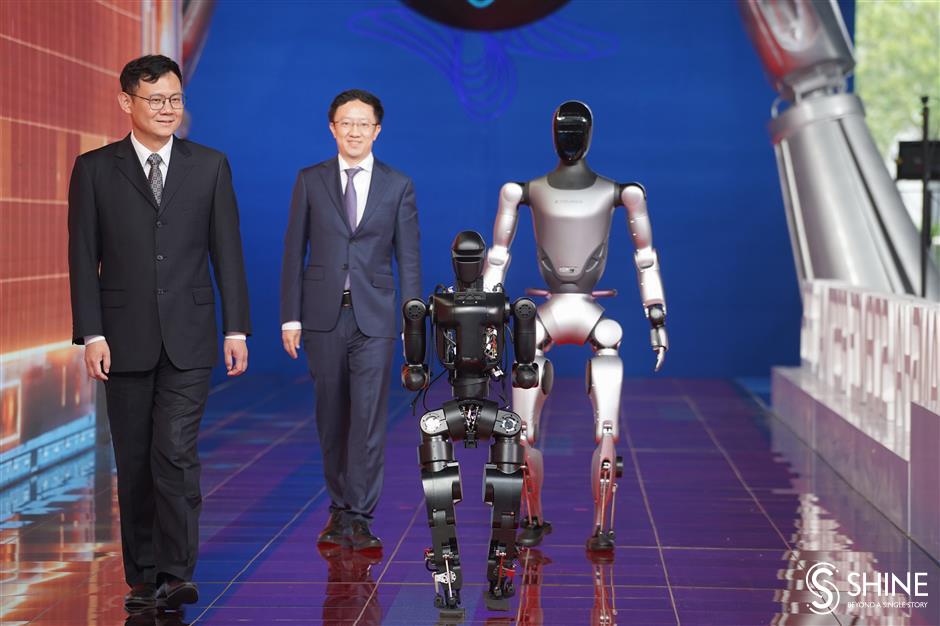
Ti Gong
A huge humanoid robot waves hands in the virtual world while humanoid robots walk the red carpet in real world.
Humanoid robots strutted down a red carpet alongside scientists and tech leaders at the opening of the 2025 Shanghai Science Festival on Saturday, blending a high-tech spectacle with public science engagement.
Held at Zhangjiang Science Hall, the event spotlighted China’s rapidly advancing robotics industry, positioning Shanghai as a showcase for emerging technologies including AI, XR, and humanoid automation.
Fourier’s founder and CEO Gu Jie, and vice president Zeng Xiang, walked the carpet with two humanoid robots developed by the company: GR-2 and N1.

Jiang Xiaowei / SHINE
Fourier’s founder and CEO Gu Jie (second from the left) and vice president Zeng Xiang (left) with two humanoid robots developed by the company.
The GR-2 stands 1.75 meters tall, weighs 63 kilograms, and is designed for heavy lifting and interactive training. It can carry more than 10 kilograms and is being developed for physical labor tasks across industries.
The smaller N1 model focuses on endurance, and is capable of running for more than two hours on a single charge. It is also fully open-source, with all blueprints and code publicly available, offering developers around the world a platform for collaboration and experimentation.
“When a 1.75-meter-tall robot walks alongside a human on the red carpet, it’s not just for show. It’s a glimpse into what’s possible,” said Gu. “These robots have undergone tens of thousands of hours of testing across various terrains and scenarios.”
Another crowd-pleasing moment came from Agibot’s A2 robot, which performed a tai chi routine while explaining the martial art in real time. The 1.69-meter-tall robot moved with surprising fluidity, drawing applause from the audience.

Ti Gong
Agibot’s humanoid robot plays tai chi on the red carpet.
“The pace of development is incredible,” said Wang Chuang, Agibot’s general product line president. “Last year, some robots still stumbled while walking. This year, they’re performing. The red carpet is a perfect stage to show how fast we’re advancing.”
The company has hundreds of humanoid robots deployed in real-world settings, with each unit produced on a standardized manufacturing line – “ready to use, like a car,” he added.
This year’s red carpet also featured an upgraded AI-powered experience using XR. As guests walked, their movements were merged live with dynamic virtual environments – from an immersive “brain universe” to surreal, aurora-lit dreamscapes – each reflecting the creativity and innovation behind their work.

Ti Gong
A purple ocean where a huge whale is swimming appears at the site when Jo Quinton-Tulloch, director of the UK’s National Science and Media Museum, and Ni Minjing, director of the Shanghai Science and Technology Museum, walk on the red carpet.

Ti Gong
Ni Minjing, director of the Shanghai Science and Technology Museum and Quinton-Tulloch, director of the UK’s National Science and Media Museum.
The event drew a diverse crowd: top scientists, start-up founders, science influencers, and young inventors.
International guests included Jo Quinton-Tulloch, director of the UK’s National Science and Media Museum, and Cho Sook-kyoung, president of the Network for the Public Communication of Science and Technology (PCST).
One emotional highlight saw neuroscientist Mu-Ming Poo and cell biologist Yuan Junying encounter AI-generated younger versions of themselves.
Yuan embraced her 18-year-old self and said: “I want to tell my 18-year-old self that you’ve made the right choice. That’s something I truly believe.”
Shanghai ranks sixth in global science communication
Shanghai’s role in global science communication is equally impressive.
At the Science Communication Conference held just after the red carpet show, Shanghai Jiao Tong University announced it will host the 19th biennial PCST conference in 2027 – the first time China will host this event.
Zeng Xiaoqin, the university’s vice president, said the university also plans to release a global report on science communication development and launch a new “China Initiative” to further advance the field.
This milestone comes as Shanghai cements itself as a powerhouse in science outreach. The “Global Urban Science Communication Capacity Index 2025,” unveiled by Xu Jian, deputy director of the university’s School of Media and Communication, ranks Shanghai sixth worldwide – second only to Tokyo in Asia.

Ti Gong
Xu Jian, deputy director of the university’s School of Media and Communication, unveils the “Global Urban Science Communication Capacity Index 2025.”
The report assessed 40 major cities across six continents, ranking New York first, followed by London and Boston. Other Chinese cities included Beijing (7th), Hong Kong (12th), Taipei (22nd), Shenzhen (23rd), Hangzhou (25th), and Guangzhou (26th).
The index mainly looks at how well research institutions, companies, governments, and media share and communicate science with the public.
New York leads by excelling across scientific outreach, organized communication, and public engagement. London and Boston follow closely, thanks to their vibrant scientific communities and diverse communication channels.
Shanghai’s high ranking reflects rapid growth in science communication. It leads in offline public participation (1st), ranks fourth in media-driven outreach, and fifth in scientists’ communication impact.
Zeng emphasized the PCST 2027’s vision.
“We want this conference to bring science closer to everyday life,” he said.
“By building an innovative science communication network across the Yangtze River Delta, Shanghai aims to become a global hub for science communication and innovation.
“This will strengthen China’s influence worldwide and inspire more people, especially youth, to engage with science and become future scientists.”












